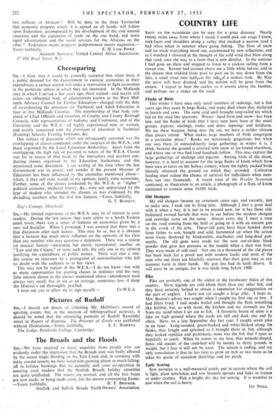Flocks of Birds
This winter I have seen only small numbers of redwings, but a few years ago they came In large flocks, and many died where they sheltered in laurels and yews. The same cold spell brought long-tailed tits which fed on the road like sparrows. Winter—hard frost and snow—has been late, and the flocks of birds that I have seen have been of the usual groups, pigeons, starlings, rooks and daws, lapwings and fieldfares. We see these because, being near the sea, we have a milder climate than places inland. What makes large numbers of birds congregate in a particular place ? Rooks are notoriously gregarious, but when one sees them in extraordinarily large gatherings in winter it is, I think, because the ground is covered with snow or ice-bound elsewhere, and where one or two find food hundreds follow. This may explain the large gatherings of starlings and pigeons. Among birds of the shore, however, it is hard to account for the large flocks of knots which have been seen at times on the Solway estuary, where the tightly packed birds literally obscured the ground on which they-crowded. Collective feeding must reduce the chance of survival for individuals when num- bers run into thousands. , A recent issue of the Weekly Scotsman contained, as illustration to an article, a photograph of a flock of knots estimated to contain some 10,000 birds.


































 Previous page
Previous page